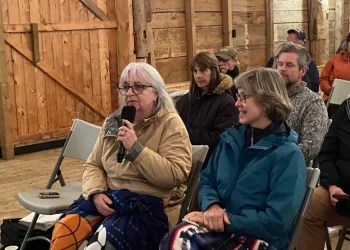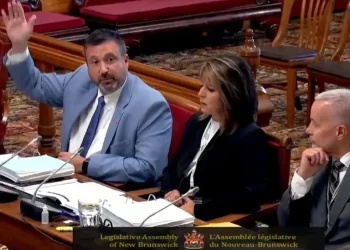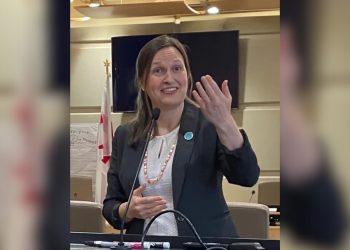The booming voice of an American news anchor echoed inside the Mount Allison University Chapel on Sunday as fifth year biology student Nate Lesser showed a TV report from Tennessee.
“A proposed gas plant in South Memphis is raising concerns tonight. Fox 13 continues to bring you the latest coverage on our contaminated communities where people young and old have been exposed to pollutants for decades,” said anchor Bob Evans.
The story was about the Tennessee Valley Authority’s 2023 proposal to build another natural gas generating plant next to an existing one.
“We need something that we can turn on quickly when the sun’s not shining and then turn back off again,” said TVA spokesperson Scott Brooks while Keshaun Pearson, president of the Memphis Community Against Pollution called it “environmental injustice” adding: “We continue to be flooded with opportunities to increase gas and archaic infrastructure, options that don’t help, that continue to hurt the community.”
When the news report ended, Lesser, who is researching the proposed 500 MW Centre Village gas/diesel plant as part of a Religious Ethics and Environment course, said the citizens group in South Memphis has succeeded in delaying the gas plant there and maybe it would be possible to do that here too.
‘Imagine a better future’
“We can imagine a better future than gas turbines in our backyard,” Lesser said, adding that Canada is already a leader in developing grid-scale battery technologies.

Instead of investing in outmoded gas plants, he argued, we could imagine a brighter, more prosperous future.
“We have an opportunity to really get in on the ground floor of this very exciting next step of what energy would look like for the next century. But we’re building a gas plant,” he said.
“No we’re not,” a woman called from among the 50 gathered in the chapel for a public information session organized by the Protect the Chignecto Isthmus Coalition.
“Maybe, we’re building a gas plant,” Lesser said.
“We’re not,” the woman repeated as people laughed.
Lesser smiled and said it was great to have a “real-time discussion” with the community as he urged people to talk to their friends.
“We can do better things, so let’s do better things,” he concluded to loud applause.
‘Climate anxiety’
Isabella Jones, who is doing an independent study of eco-poetry and climate change as part of her Honours English degree, spoke about growing up in St. George, 25 minutes from the Point Lepreau nuclear plant and 20 minutes from the Lake Utopia pulp and paper mill.
“I remember we would drive past the mill to get to school,” she said, “and my mom used to call it Stinky Hollow. We’d plug our noses and hold our breath.”
She remembered how her parents, who were teachers, had colleagues who lived 10 kilometres from Point Lepreau.
Their two-year-old daughter developed a rare bone disease.
“The entire left side of her body, the bones don’t grow, but the right side does,” Jones said, adding that the girl will require bone grafts until she stops growing.
“Her family felt they couldn’t understand why this was happening,” she said, especially since there were no genetic markers among them and tests were inconclusive.
“They felt because they lived 10 kilometres from Point Lepreau, they were no longer safe in their home,” she added, “so they moved and our community lost some coaches and teachers because they no longer felt safe.”
Jones talked about other examples of illness in her community as well as severe floods and fires she linked to climate change.
“I think of how this affected me, how this affected my community — this climate anxiety, this health anxiety.”
She warned the audience that 20 years from now, some kid like her might ask why there is smoke in the air and why the air stinks.
“And I don’t want them to ask, ‘Did you oppose this? Is there anything else you could have done?’”
This is the first of two reports on Sunday’s public information session at the Mt. A. Chapel.
Bruce Wark worked in broadcasting and journalism education for more than 35 years. He was at CBC Radio for nearly 20 years as senior editor of network programs such as The World at Six and World Report. He currently writes for The New Wark Times, where a version of this story first appeared on November 17, 2025.




![Radioactivity and nuclear waste under scrutiny in Peskotomuhkati homeland [video]](https://nbmediacoop.org/wp-content/uploads/2025/10/EdwardsAkagiOct52025-1-350x250.jpg)


![‘Continuum of genocide’: Pentagon funding of Sisson mine provokes renewed opposition from Wolastoq Elders [video]](https://nbmediacoop.org/wp-content/uploads/2025/07/SissonMine-2-120x86.jpg)


